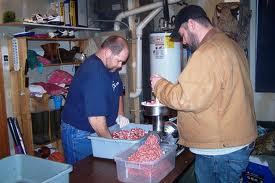Thoughts About Lead Poisoning for Hunters and Their Dinner Guests
 International and domestic studies have shown elevated lead levels in humans consuming large and small game hunted with lead ammunition. Studies prove that regular consumption of game meat in adults and children found elevated blood lead levels compared with background levels, especially among children.
International and domestic studies have shown elevated lead levels in humans consuming large and small game hunted with lead ammunition. Studies prove that regular consumption of game meat in adults and children found elevated blood lead levels compared with background levels, especially among children.
In terms of lead ingestion, risk is dependent on how much lead is consumed and the frequency of exposure; therefore, limiting the total amount of lead exposure reduces harm. Factors that increase dietary lead exposure from spent lead bullet fragments in wild game include:
•The frequency and amount of hunted game that a person consumes.
•The age of the person consuming the meat.
•The degree of bullet fragmentation.
•The path which the bullet enters the wildlife.
•The care with which the meat surrounding the bullet wound is removed
•The use of any acidic treatments of the meat that would dissolve the lead (such as coating the carcass with vinegar or use of acidic marinades in cooking), which can increase exposure.
•Fragmentation that occurs due to the bullet hitting something hard (e.g., bone).
Important Considerations When Processing Your Bounty:
There is expected to be a higher incidence of lead bullet fragments in ground meats than in loins or roasts because meat trimmed away from the bullet channel can contain more fragments. This is because the muscle tissue around the wound channel is not discarded, but rather is used in burger, stews, and sausages. It is recommended that the tissue around the wound channel be removed during food preparation.
Variation in lead concentrations in small animals such as birds is large, most likely due to the shooting skill of the hunter. Birds where the hunter has not destroyed the body in killing it will have less lead exposure when consumed.
When preparing venison, avoiding vinegar and other acidic substances is suggested, as acids can make lead more soluble and therefore more readily absorbed in the body. Also, when processing, minimizing the batching of multiple deer is thought to reduce cross-contamination.
Ways to avoid the problem:
 You could switch to archery! If that is not an option for you consider use of non-toxic ammunition. Currently, the US Fish and Wildlife Service approves the use of 11 types of non-toxic shell-shot with various material compositions. For example shell-shot is available in steel, bismuth, tungsten, and tin. Also, bullets are available in copper and metal alloys. The picture to the left shows he difference when a lead and a copper bullet were fired into a barrell. The copper bullet mushroomed while its lead counterpart shredded during a recent demonstration at Waterloo, Wisc. Gun Club.
You could switch to archery! If that is not an option for you consider use of non-toxic ammunition. Currently, the US Fish and Wildlife Service approves the use of 11 types of non-toxic shell-shot with various material compositions. For example shell-shot is available in steel, bismuth, tungsten, and tin. Also, bullets are available in copper and metal alloys. The picture to the left shows he difference when a lead and a copper bullet were fired into a barrell. The copper bullet mushroomed while its lead counterpart shredded during a recent demonstration at Waterloo, Wisc. Gun Club.
Note:
This information was summerized from "Lead Issues at National Park Service Units:Identifying Potential Sources and Minimizing Exposure" by the National Park Service Office of Public Health
 Actually this is about helping spread the word to children and parents about avoiding the dangers of lead exposure.
Actually this is about helping spread the word to children and parents about avoiding the dangers of lead exposure.  I suggest renovators could use this video on their website. Consider creating an area on your site dedicated to the RRP Rule. Make it a place that offers information, advice and links that would help visitors understand the rule and the realities of lead exposure. If you do so you can send prospects and customers to your site to help pre-educate them prior to a sales call or before beginning work at their home.
I suggest renovators could use this video on their website. Consider creating an area on your site dedicated to the RRP Rule. Make it a place that offers information, advice and links that would help visitors understand the rule and the realities of lead exposure. If you do so you can send prospects and customers to your site to help pre-educate them prior to a sales call or before beginning work at their home. 
 Looking for accurate information about the EPA RRP rule?
Looking for accurate information about the EPA RRP rule? 


 A recent example of this related to lead in construction is discussed in an
A recent example of this related to lead in construction is discussed in an  At the San Juan National Historic Site project eight alleged serious violations resulted from a lack of medical evaluations and fit-testing for employees using respirators, improper storage of compressed gas cylinders, no eye-wash stations where employees worked with corrosive products, an uncovered electrical receptacle, a lack of hazard communication training and material data sheets of the products used, and not implementing hazard communication and written respiratory protection programs.
At the San Juan National Historic Site project eight alleged serious violations resulted from a lack of medical evaluations and fit-testing for employees using respirators, improper storage of compressed gas cylinders, no eye-wash stations where employees worked with corrosive products, an uncovered electrical receptacle, a lack of hazard communication training and material data sheets of the products used, and not implementing hazard communication and written respiratory protection programs. “There is a new sheriff in town. Make no mistake about it; the Department of Labor is back in the enforcement business… Under my watch, enforcement of labor laws will be intensified to provide an effective deterrent to employers who put their workers’ lives at risk.”
“There is a new sheriff in town. Make no mistake about it; the Department of Labor is back in the enforcement business… Under my watch, enforcement of labor laws will be intensified to provide an effective deterrent to employers who put their workers’ lives at risk.” One big reality of the current recession is the need for everyone to cut back their budgets. This holds true for most Americans, businesses and nonprofits. It has now also started to become a reality for our government. A recent discussion posted to LinkedIn includes a link to an article that is titled
One big reality of the current recession is the need for everyone to cut back their budgets. This holds true for most Americans, businesses and nonprofits. It has now also started to become a reality for our government. A recent discussion posted to LinkedIn includes a link to an article that is titled
 Doesn’t it make sense to concentrate funding on efforts that would prevent lead poisoning to begin with, rather than justify that money from the government is needed to help those already poisoned? Why is it they are they still getting poisoned? Plus, it would probably be much less expensive to prevent the problem than it would be to deal with it after it has occurred.
Doesn’t it make sense to concentrate funding on efforts that would prevent lead poisoning to begin with, rather than justify that money from the government is needed to help those already poisoned? Why is it they are they still getting poisoned? Plus, it would probably be much less expensive to prevent the problem than it would be to deal with it after it has occurred. International and domestic studies have shown elevated lead levels in humans consuming large and small game hunted with lead ammunition. Studies prove that regular consumption of game meat in adults and children found elevated blood lead levels compared with background levels, especially among children.
International and domestic studies have shown elevated lead levels in humans consuming large and small game hunted with lead ammunition. Studies prove that regular consumption of game meat in adults and children found elevated blood lead levels compared with background levels, especially among children. 

 On a web site by the name of
On a web site by the name of  Like construction workers who are exposed to lead in the course of their work, Gardeners should also consider that their skin and their clothes may become contaminated. Always wash your hands immediately after gardening and definitely before eating, drinking or smoking to avoid ingesting lead dust. To reduce the risk of bringing lead contaminated soil into the home, rinse and launder gardening clothing promptly. Being educated about the dangers of lead and ways to protect yourself as well as your family can help make sure you’re not growing a lead problem in your garden.
Like construction workers who are exposed to lead in the course of their work, Gardeners should also consider that their skin and their clothes may become contaminated. Always wash your hands immediately after gardening and definitely before eating, drinking or smoking to avoid ingesting lead dust. To reduce the risk of bringing lead contaminated soil into the home, rinse and launder gardening clothing promptly. Being educated about the dangers of lead and ways to protect yourself as well as your family can help make sure you’re not growing a lead problem in your garden. 


